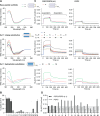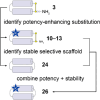Enhancing the Intrinsic Antiplasmodial Activity and Improving the Stability and Selectivity of a Tunable Peptide Scaffold Derived from Human Platelet Factor 4
- PMID: 39087267
- PMCID: PMC11320574
- DOI: 10.1021/acsinfecdis.4c00276
Enhancing the Intrinsic Antiplasmodial Activity and Improving the Stability and Selectivity of a Tunable Peptide Scaffold Derived from Human Platelet Factor 4
Abstract
The control of malaria, a disease caused by Plasmodium parasites that kills over half a million people every year, is threatened by the continual emergence and spread of drug resistance. Therefore, new molecules with different mechanisms of action are needed in the antimalarial drug development pipeline. Peptides developed from host defense molecules are gaining traction as anti-infectives due to theood of inducing drug resistance. Human platelet factor 4 (PF4) has intrinsic activity against P. falciparum, and a macrocyclic helix-loop-helix peptide derived from its active domain recapitulates this activity. In this study, we used a stepwise approach to optimize first-generation PF4-derived internalization peptides (PDIPs) by producing analogues with substitutions to charged and hydrophobic amino acid residues or with modifications to terminal residues including backbone cyclization. We evaluated the in vitro activity of PDIP analogues against P. falciparum compared to their overall helical structure, resistance to breakdown by serum proteases, selective binding to negatively charged membranes, and hemolytic activity. Next, we combined antiplasmodial potency-enhancing substitutions that retained favorable membrane and cell-selective properties onto the most stable scaffold to produce a backbone cyclic PDIP analogue with four-fold improved activity against P. falciparum compared to first-generation peptides. These studies demonstrate the ability to modify PDIP to select for and combine desirable properties and further validate the suitability of this unique peptide scaffold for developing a new molecule class that is distinct from existing antimalarial drugs.
Keywords: Plasmodium; drug development; host defense peptide; malaria; rational design; targeted cell-penetration.
Conflict of interest statement
The authors declare no competing financial interest.
Figures







Similar articles
-
Insights into platelet factor 4-derived peptide macrocycles; the mechanistic basis of their rapid and selective antiplasmodial actions.Cell Mol Life Sci. 2025 Jun 9;82(1):228. doi: 10.1007/s00018-025-05757-y. Cell Mol Life Sci. 2025. PMID: 40490548 Free PMC article.
-
Defense Peptides Engineered from Human Platelet Factor 4 Kill Plasmodium by Selective Membrane Disruption.Cell Chem Biol. 2018 Sep 20;25(9):1140-1150.e5. doi: 10.1016/j.chembiol.2018.06.009. Epub 2018 Jul 19. Cell Chem Biol. 2018. PMID: 30033131
-
Exploring the Utility of Cell-Penetrating Peptides as Vehicles for the Delivery of Distinct Antimalarial Drug Cargoes.ChemMedChem. 2025 Jan 14;20(2):e202400637. doi: 10.1002/cmdc.202400637. Epub 2024 Nov 12. ChemMedChem. 2025. PMID: 39379289
-
Hybrid molecules with potential in vitro antiplasmodial and in vivo antimalarial activity against drug-resistant Plasmodium falciparum.Med Res Rev. 2020 May;40(3):931-971. doi: 10.1002/med.21643. Epub 2019 Nov 6. Med Res Rev. 2020. PMID: 31692025 Review.
-
A Structural Chemistry Perspective on the Antimalarial Properties of Thiosemicarbazone Metal Complexes.Mini Rev Med Chem. 2019;19(7):569-590. doi: 10.2174/1389557518666181015152657. Mini Rev Med Chem. 2019. PMID: 30324878 Review.
Cited by
-
Insights into platelet factor 4-derived peptide macrocycles; the mechanistic basis of their rapid and selective antiplasmodial actions.Cell Mol Life Sci. 2025 Jun 9;82(1):228. doi: 10.1007/s00018-025-05757-y. Cell Mol Life Sci. 2025. PMID: 40490548 Free PMC article.
-
Exploring Use of a Protein Cage System for Producing Bioactive Peptides in Escherichia coli.Microb Biotechnol. 2025 Jun;18(6):e70158. doi: 10.1111/1751-7915.70158. Microb Biotechnol. 2025. PMID: 40457540 Free PMC article.
References
-
- World Health Organisation . World Malaria Report 2023; Licence: CC BY-NC-SA 3.0 IGO: Geneva, 2023.
-
- Balikagala B.; Fukuda N.; Ikeda M.; Katuro O. T.; Tachibana S.-I.; Yamauchi M.; Opio W.; Emoto S.; Anywar D. A.; Kimura E.; Palacpac N. M. Q.; Odongo-Aginya E. I.; Ogwang M.; Horii T.; Mita T. Evidence of artemisinin-resistant malaria in Africa. N. Engl. J. Med. 2021, 385 (13), 1163–1171. 10.1056/NEJMoa2101746. - DOI - PubMed
MeSH terms
Substances
LinkOut - more resources
Full Text Sources
Miscellaneous

